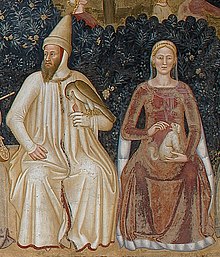Viridis Visconti
Viridis Visconti (* around 1350 - March 1, 1414 ), Duchess of Milan and Duchess of Austria, came from the union of Bernabò Visconti , Lord of Milan, and Beatrice della Scala, daughter of Mastino II of Verona.
ancestry

On his father's side, Viridis came from the Ghibelline, i.e. imperial-minded noble family of the Visconti . They were a Lombard aristocratic family that gained rule over Milan around 1277. Gian Galeazzo Visconti (1351-1402) was made Duke of Milan by King Wenceslaus .
On her mother's side, Viridis came from the noble family of Scaliger ( Scaligeri , della Scala , German often also Scaliger ), which was also imperial-minded ; they were lords of Verona from 1260 to 1387. The brothers Alberto II and Mastino II , the latter grandfather of the Viridis, were considered the richest and most powerful princes of their generation in Italy. Co-reign, as well as relatives and fratricide, were common within the sex in the struggle for power.
family
Viridis married Leopold III in 1365 . , Duke of Styria (November 1, 1351 - July 9, 1386) from the House of Habsburg , who fell in the Battle of Sempach . The following children emerged from this connection:
- Wilhelm the Ambitious / Friendly (1370–1406)
- Leopold IV the Fat (1371-1411)
- Ernst the Iron (1377-1424)
- Frederick IV with the Empty Pocket (1382–1439)
- Elisabeth
Viridis and the Parakeet Monastery
Viridis is also considered the benefactress of the Parakeet Monastery . Valvasor mentioned them three times in the list of donors when describing the monastery , for the years 1397, 1404, 1414 as "Viridis born Hertzoginn von Mayland / and Hertzoginn in Austria". After the death of her husband, she settled in a farm near the monastery; but she also owned a house in Laibach. The abbot Albrecht von Lindeck , who always brought the monastery into financial difficulties due to his poor economy, often lent large sums of money in exchange for pledging monastic lands. The agreement was always that the monastery had to read masses for her and the salvation of her parents and her fallen husband. After her death, all lands are to be returned to the monastery and she is to be buried in the monastery; a wish that was also fulfilled. (According to other sources, she is said to have been buried in the family crypt in Milan).
literature
- Lexicon of History . Gütersloh / Munich 1998, ISBN 3-572-01285-6
- Jože Gregorič: Cistercijani v Stični (Cistercians in Parakeets). Ljubljana 1980.
- Jože M. Grebenc: Gospodarska ustanovitev Stične ali njena dotacija 1135 (The economic foundation of the parakeet or its endowment). Samostan Stična (Parakeet Monastery) 1973.
- Jože Mlinarič: Kostanjeviška opatija 1234–1786 (The Landstrasse Abbey 1234–1786). Ljubljana 1987.
- JW von Valvasor : Honor . Volume III, facsimile, Heppenheim 1971.
- Richard Reifenscheid: The Habsburgs. From Rudolf I. to Karl I. Verlag Styria, Graz / Vienna / Cologne 1982, pp. 46, 53, 72.
- Andreas Thiele: Narrative genealogical family tables on European history. Volume II, Part 2: European Imperial, Royal and Princely Houses II Northern, Eastern and Southern Europe . RG Fischer Verlag, 1994, plate 441a.
- Hellmut Andics : The women of the Habsburgs. 1st edition, Vienna 1969, ISBN 978-3-8000-3746-9 .
Web links
- Barbara Tuchman in: http://www.wfelix.org/tuchman.html
Individual evidence
- ↑ cf. Monika Schellmann: On the history of Duke Ernst the Iron (1386 / 1402-1424), dissertation (unprinted), Vienna, 1966, p. 14
| personal data | |
|---|---|
| SURNAME | Visconti, Viridis |
| BRIEF DESCRIPTION | Duchess of Milan and Duchess of Austria |
| DATE OF BIRTH | around 1350 |
| DATE OF DEATH | March 1, 1414 |